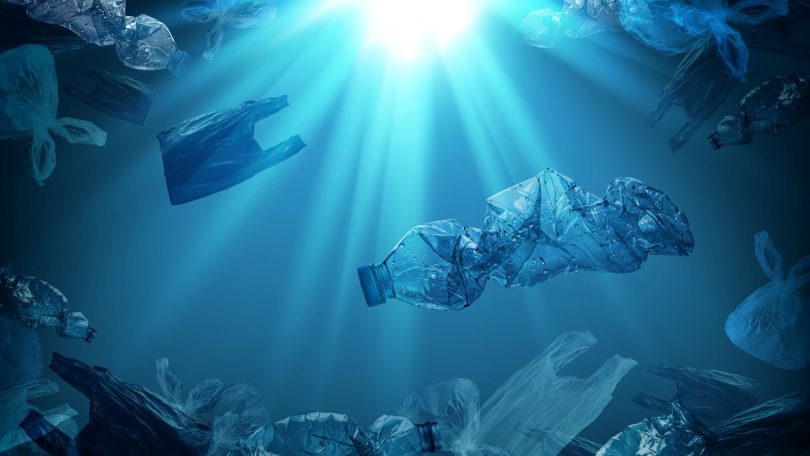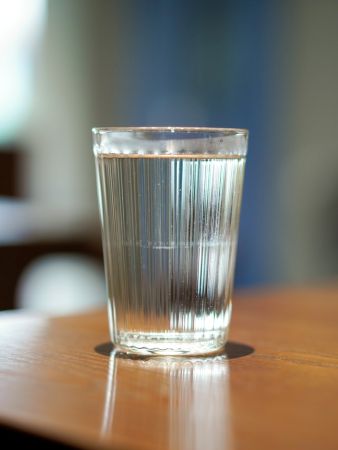A Double-Edged Sword
Nothing divides opinion quite like plastic. Plastic is lauded (quite rightly) for being polluting to soils and waterways. It’s been found lurking in the deepest parts of the oceans and on the most remote of beaches. But plastic is also convenient, cheap, hygienic and lightweight.
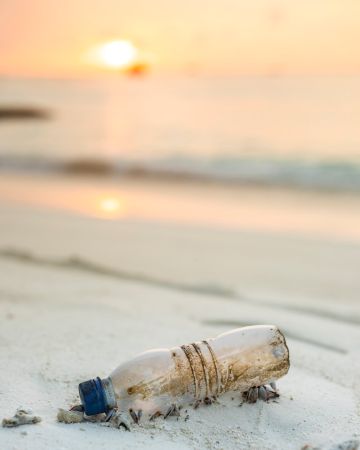
Compared to glass, it’s cheaper and takes less carbon to transport. When compared to paper, it offers more protection, prolonging the life of certain foods, therefore reducing food waste. However, this also means that it’s used to package pretty much everything, including many, many of the things we eat and drink.
There’s emerging evidence of its potential harm to animals & humans…
…so what does this mean for us, in a plastic reliant world?
And what can we do to change things?
Where is All This Plastic Coming From, & Where Does it End Up?
The problem of plastic pollution is wide and convoluted. In our own homes, there isn’t a room without plastic in it – from the food wrappers in our kitchens to the bottles, tubs and tubes in our bathrooms and synthetic clothes in our wardrobes. (Fabrics often contain plastic microfibers – anything with the word ‘poly’ in it is plastic, so polyester etc.)
Manufacturers and supermarkets also get through thousands of tonnes of plastic each week, transporting and packaging our food, beauty products, cleaning products, clothes, furniture and pretty much everything else. The real demon is single use plastic, by both consumers and manufacturers, that’s used once and thrown away.
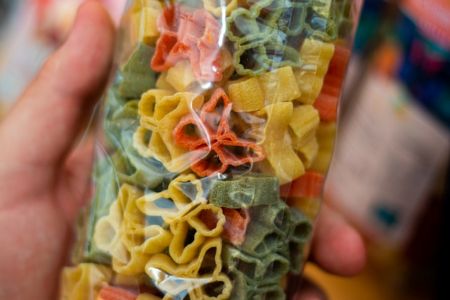
(Even recycling plastic has its problems since it can only be recycled a few times, and even then, some soft plastics aren’t widely recycled.)
Plastics that end up in landfill leach their chemical components into the ground, and over time they break down enough to become tiny particles called microplastics. These microplastics (along with larger pieces of plastic, most notably from the fishing industry in the form of discarded nets that then themselves become microplastics) find their way into the worlds’ seas and oceans. They’re then eaten unwittingly by small fish, who are then eaten by larger fish and sea birds, and they’re now known to be entering the human food chain.
Studies have shown that microplastics are in human stools too, so they’re passing through our digestive systems and returning to the environment. Alarmingly, every single piece of plastic ever produced, still exists in some form or another.
Be that in the car you’ve owned since the 1980s, in the Lycra jeans you’ve owned since the 2000s, recycled into something else, languishing in landfill, floating around in the sea, or in your body.
What’s the Impact of Ingesting Microplastics?
At the moment, the full extent of the potential health issues that could be caused by ingesting microplastics isn’t yet fully understood. However, there are links to endocrine disruption (messing with our natural hormone levels and cycles), reproductive problems and potentially some cancers.
Despite the current unknowns, the fact alone that synthetic polymers are building up in our bodies is certainly unnerving and worrying. Especially since chemical pollutants, such as those used in perfumes and aftershaves, as well as those used to scent cleaning products and air fresheners in our homes, can bind to the microplastics in our bodies and become lodged in our fatty tissues.
This chemical-plastic cocktail is what concerns researchers the most. Reducing the amount of plastic we buy and use is therefore the key to reducing any risks associated with ingesting microplastics.
Eight Glasses a Day, With Ice & A Slice (of Synthetic Polymer Particles…)
One of the most common examples of single-use plastic is the water bottle. While staying hydrated is vital for our health, grabbing a plastic bottle of water when out and about is a common habit.
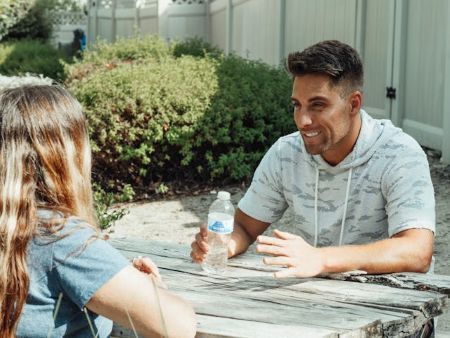
However, is bottled water as healthy as we think? Studies have found that bottled water contains microplastics. A global study of over 250 bottled waters revealed that 93% contained synthetic polymer particles. Some were even visible to the naked eye. On average, bottled water contained 325 microplastic particles per litre.
Exposure to heat worsens the problem. When plastic bottles are left in hot environments, such as a car on a sunny day, chemicals leach into the water at a higher rate.
Is Tap Water The Answer?
It’s thought that tap water is around 500 times cheaper than bottled water. It’s easily accessible too, we just turn on the kitchen tap and it’s there, ready to drink. However, there could be dangerous chemicals hiding in our ‘clean’ tap water. These include per- and polyfluoroalkyl substances, or PFAS, otherwise known as forever chemicals. These chemicals are found everywhere from non-stick pans to crease-free, non-iron clothing, fire retardant furniture and stain resistant carpets. They find their way into the environment and waterways, and end up in our drinking water supplies. In the US, a study linked PFAS to high cholesterol, cancers of the kidneys and testicles, inflammatory bowel disease and thyroid disease.
In addition to this, tap water tends to have a pH of around 7, which places it in the neutral range of acid and alkaline. However, drinking water that has a higher pH, making it more alkaline is thought to improve its quality.
How Can We Make Water More Alkaline?
Alkaline water contains mineral elements and oxides of minerals that give normal tap water the beneficial properties of natural spring water – minus the plastic bottle. This means that alkaline water has a higher antioxidant content that can benefit our physical health.
How To Reduce Our Reliance on Plastic
For both environmental and health reasons, reducing our plastic consumption is essential. In particular, cutting down on single-use plastics can make a significant impact.
Here are some practical ways to reduce plastic use:
- Use a reusable water bottle and fill it from an alkaline water ionizer.
- Carry reusable eating utensils and a packed lunch box for leftovers.
- Bring reusable shopping bags when you shop—keep them in your car, handbag, gym bag, or by the front door.
- Choose supermarkets that sell loose fruit and vegetables instead of pre-packaged options.
- Buy meat and fish from butchers or fishmongers and ask them to wrap it in your own containers.
- Visit refill shops to stock up on dry goods like pasta, rice, cereals, flour, and dried herbs.
- Opt for bars of soap instead of liquid soap in plastic bottles.
- Look for plastic-free brands for common household and beauty products.
- Use a bamboo toothbrush and reusable face cloths instead of disposable wipes.
- Choose clothes made from natural fibres such as cotton, hemp, and linen.
Reducing our reliance on plastic may seem daunting, but small, consistent changes can make a significant impact. By making mindful choices—whether it’s using a reusable bottle, shopping more sustainably, or choosing plastic-free alternatives—we can help protect both our environment and our health. Every step towards a plastic-free lifestyle is a step towards a cleaner, healthier future for ourselves and generations to come.
References
- https://www.greenpeace.org/eastasia/blog/6016/3-everyday-foods-that-contain-microplastics/
- https://www.theguardian.com/environment/2018/oct/22/microplastics-found-in-human-stools-for-the-first-time
- https://pubmed.ncbi.nlm.nih.gov/34611754/
- https://www.theguardian.com/environment/2022/jan/16/toxic-reaction-how-to-clear-dangerous-pollutants-out-of-your-home
- https://time.com/5581326/plastic-particles-in-bottled-water/
- https://www.ncbi.nlm.nih.gov/pmc/articles/PMC6141690/
- https://www.nationalgeographic.co.uk/environment-and-conservation/2019/07/exposed-extreme-heat-plastic-bottles-may-ultimately-become
- https://firstbusinesswater.co.uk/bottled-water-or-tap-water/ https://www.theguardian.com/environment/2021/mar/25/uk-flying-blind-on-levels-of-toxic-chemicals-in-tap-water
- https://www.eea.europa.eu/publications/emerging-chemical-risks-in-europe

